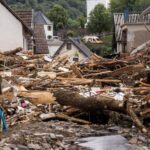The global insurance industry can currently expect a long-run annual average loss of $106 billion and a greater than a 40 percent chance of experiencing an annual loss of more than $200 billion in the next decade, according to Boston-based modeling firm AIR Worldwide.
AIR estimates there’s a 5 percent probability of insurance industry losses exceeding $203 billion in a given year (with a 20-year return period), explained Vijay Padmanabhan, vice president at AIR Worldwide, during an interview with Insurance Journal to discuss AIR’s recent catastrophe loss report, titled Global Modeled Catastrophe Losses, October 2021.
“Over the next 10 years, there’s a 1 percent chance of losses being higher than $320 billion (with a hundred-year return period) in any given year, while there is a 0.4 percent likelihood that losses could hit $397 billion (with a 250-year return period),” he explained.
The annual average loss (AAL) of $106 billion “notably exceeds the actual average [annual] loss of the past decade of approximately $75 billion and is a stark reminder that we have been fortunate to not have had a major tropical cyclone or earthquake event in a highly populated region,” said Bill Churney, president of AIR Worldwide, in a statement accompanying the report’s publication.
AIR calculates the 10-year average of insured losses to be about $75 billion, but the higher losses of the past few years are not model outliers because the models take into account the possibility of tail risk such as 20-, 100- and 250-year return periods, explained Kevin Long, senior director, Public Relations & Social Media for AIR, during the interview. (See chart below).
“Our models are showing actual losses on an annual average loss basis could be much higher,” said Long. “So years like this year and last year are not outliers because in fact such years have been considered by our models for quite some time.”
This year the industry has experienced losses above $70 billion, year to date, which is lower than AIR’s AAL of $106 billion, said Padmanabhan.
Insured Properties in High-Hazard Areas
In its report, AIR said average annual insured losses and the metrics for all regions and perils modeled by AIR have generally increased since its first white paper was published in 2012.
“This is expected; the rise reflects both increases in the numbers and values of insured properties in areas of high hazard and the inclusion of regions and perils for which new models are now available,” said the report.
Long explained that the numbers also will continue to rise as new models and perils are added to AIR’s portfolio.
As an example, Padmanabhan said that recent model updates have incorporated more precipitation induced flooding, which is being exacerbated by climate change. “There’s more precipitation associated with hurricanes, which is something we’ve built into our models.”
“The pace of climate change will evolve over time and will likely lead to larger losses…,” he noted.
See AIR’s website portal on climate change for more information on how the frequency and intensity of atmospheric perils such as tropical cyclones, extratropical cyclones, severe storms, wildfires, inland floods and coastal floods might change as the climate warms.
Insurance Protection Gap
In its latest modeling report, AIR has determined that global economic losses (which included insured, uninsured losses, as well as losses from non-insurable sources such as infrastructure and lost economic productivity) are about three times higher than global insured losses on average, when trended to 2020 dollars. As a result, AIR’s modeled global insured AAL of $106 billion would correspond to an economic AAL of more than $320 billion.
The so-called insurance protection gap between insured and uninsured losses “limit a country’s ability to recover from a major extreme event,” said AIR’s report.
On a regional basis, the percentage of economic loss from natural disasters, which is insured, varies considerably, AIR added.
The AIR report pointed to the fact that in North America about 50 percent of the economic loss from natural disasters is insured, while in Asia and Latin America, insured losses account for only about 12 percent and 24 percent of economic losses, respectively, which reflects the very low insurance penetration in these regions.
The portion of economic losses that is insured also varies significantly by peril, with coverage for flood and earthquake losses typically much lower than for risk from wind and fire, said AIR.
*This story ran prevously in our sister publication Insurance Journal.





















 Surge of Supercharged Hurricanes Prompt Call for Cat 6 Classification
Surge of Supercharged Hurricanes Prompt Call for Cat 6 Classification  Is the AI Boom a Bubble Waiting to Pop? Here’s What History Says
Is the AI Boom a Bubble Waiting to Pop? Here’s What History Says  What to Expect in 2026: U.S. P/C Results More Like 2024
What to Expect in 2026: U.S. P/C Results More Like 2024  Insurance Costs, Climate Concerns Factor Heavily in U.S. Home Buying Decisions
Insurance Costs, Climate Concerns Factor Heavily in U.S. Home Buying Decisions 


